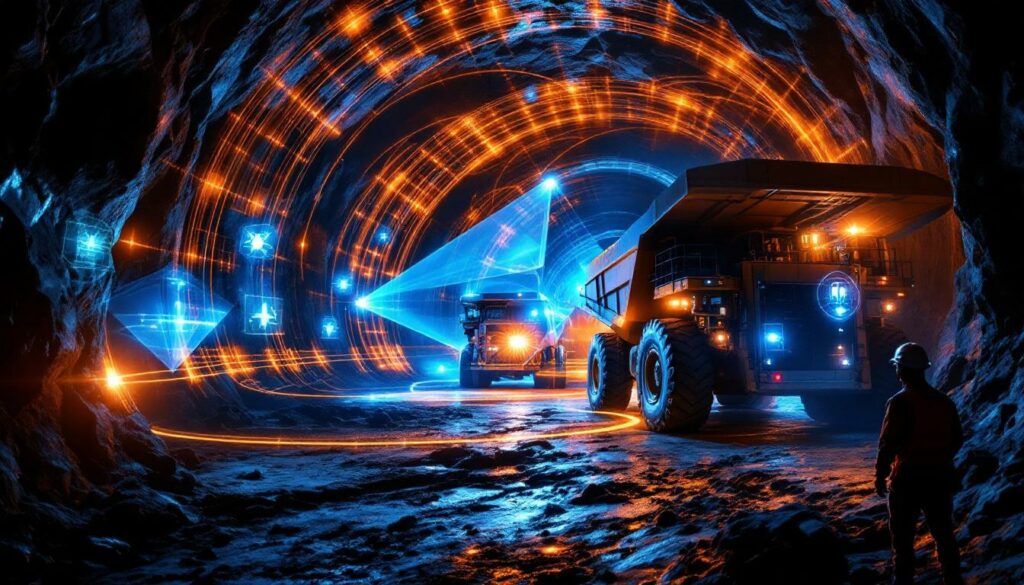Understanding Proximity Detection and Collision Avoidance in Mining
Underground mining environments present unique safety challenges due to confined spaces, limited visibility, and the operation of heavy machinery in close proximity to workers. As mining operations have grown more complex, traditional safety measures like mirrors, spotters, and basic alarms have proven insufficient in preventing vehicle-to-vehicle and vehicle-to-personnel incidents.
The mining industry evolution has seen a remarkable transformation in safety technology over the past decade, progressing from basic proximity warnings to sophisticated collision avoidance systems that can actively prevent accidents. According to the International Council on Mining and Metals (ICMM), underground mining accounts for approximately 8% of global mining fatalities despite representing only 15% of total operations, highlighting the critical need for advanced safety solutions in these environments.
"Glencore is committed to incorporating technologies that can help create a workplace free from fatalities and injuries and improve operational efficiency." – Mark Davis, CEO Copper Africa, Glencore
Key Components of Modern Collision Avoidance Systems
Modern collision avoidance systems in mining environments rely on several integrated technologies working in concert:
- Multi-sensor detection arrays: Combining radar, LiDAR, ultrasonic sensors, and camera systems to provide 360° detection coverage around vehicles
- Real-time monitoring: Continuous tracking of all moving objects within the operational environment
- Alert mechanisms: Tiered warning systems providing escalating notifications based on proximity and risk levels
- Intervention capabilities: Advanced systems can automatically slow or stop equipment when collision risk is imminent
- Data logging and analytics: Recording near-miss incidents and operational patterns to identify risk areas
These systems must function reliably in challenging underground environments characterized by dust, moisture, vibration, and limited connectivity. The most effective solutions maintain functionality even in GPS-denied zones through mesh networks and local processing capabilities.
What Makes Newtrax Collision Avoidance Technology Unique?
The Sandvik and Glencore partnership with Newtrax collision avoidance technology highlights Newtrax's distinctive approach to collision avoidance technology in the mining sector. Unlike proprietary systems that work only with specific brands of equipment, Newtrax offers a vendor-neutral solution that addresses a common challenge in mining operations: mixed fleets.
OEM-Agnostic Design: Breaking Equipment Barriers
Most mining operations maintain diverse equipment fleets from multiple manufacturers acquired over different investment cycles. This equipment diversity often results in fragmented safety systems that don't communicate with each other, creating dangerous blind spots.
Newtrax's OEM-agnostic design allows mines to implement a consistent safety standard across their entire fleet regardless of equipment manufacturer. This universal compatibility means:
- Collision avoidance systems can be retrofitted to existing equipment regardless of age or brand
- A single interface provides operators with consistent alerts and information
- Maintenance teams work with standardized components and troubleshooting procedures
- Fleet-wide safety data can be consolidated for comprehensive analysis
This approach eliminates the "compatibility gap" that often occurs when mines operate equipment from competing manufacturers with incompatible safety systems.
Scalable Protection Levels
Newtrax's technology offers a tiered approach to collision avoidance, allowing mining operations to implement safety measures appropriate to their specific needs and digital maturity:
- Level 1: Proximity Detection – Basic awareness of nearby vehicles and personnel
- Level 2: Collision Warning – Advanced notification with risk assessment
- Level 3: Collision Avoidance – System intervention capabilities
- Level 4: Automation Support – Integration with autonomous operations
This scalability enables mines to begin with fundamental safety improvements and gradually progress toward more sophisticated protection as operational experience and infrastructure develop. It also provides a migration path for operations transitioning toward automation.
"At Sandvik, we don't just talk about safety, we deliver it." – David Hallett, VP Automation, Sandvik Mining
Integration with Mining Data Platform (MDP)
Beyond immediate safety benefits, Newtrax's collision avoidance technology integrates with broader data-driven mining operations through the Mining Data Platform (MDP). This integration enables:
- Operational intelligence: Converting safety data into actionable insights
- Trend analysis: Identifying recurring near-miss patterns that may indicate infrastructure or procedural issues
- Equipment utilization optimization: Using traffic pattern data to improve mine layout and scheduling
- Compliance documentation: Automated reporting for regulatory requirements
The platform's ability to aggregate data from mixed fleets provides mining operations with comprehensive visibility previously unavailable when using siloed manufacturer-specific systems.
The Sandvik-Glencore Partnership: A Case Study in Mining Safety
The expanded partnership between Sandvik Mining and Glencore International AG represents a significant evolution in their relationship, moving beyond traditional equipment supply to comprehensive safety technology integration. This collaboration leverages Newtrax's OEM-agnostic proximity detection and collision avoidance systems to advance Glencore's zero-harm initiatives.
Current Implementation Projects
Implementation of these collision avoidance solutions is currently underway at two strategically important Glencore operations:
Kamoto Copper Company (Democratic Republic of Congo)
- One of Africa's largest copper producers
- High-density underground operations with significant vehicle traffic
- Challenging communication infrastructure environment
- Complex integration requirements with existing fleet management systems
Raglan Nickel Mine (Canada)
- Remote Arctic location with extreme weather conditions
- Operations at depths exceeding 1,000 meters
- Mix of new and legacy equipment requiring unified safety systems
- High safety standards in line with Canadian regulatory requirements
These implementations showcase the technology's adaptability across dramatically different mining environments, from the tropical conditions of central Africa to the Arctic climate of northern Canada.
"The integration of Newtrax systems reflects our focus on safety and innovation at all levels of our global operations." – Mark Davis, Glencore
Expanding Beyond Equipment Supply
The partnership marks an important shift in how OEMs and mining companies collaborate on safety initiatives. Rather than simply providing equipment with built-in safety features, Sandvik is delivering comprehensive safety solutions that:
- Extend across entire operations regardless of equipment manufacturer
- Integrate with existing infrastructure and systems
- Provide ongoing support and technology evolution
- Deliver data-driven insights beyond immediate collision prevention
This expanded relationship demonstrates how equipment manufacturers are evolving into technology partners, helping mining companies navigate the complex intersection of safety, productivity, and digital transformation.
How Does Collision Avoidance Technology Transform Mining Operations?
Safety Performance Improvements
The Sandvik and Glencore partnership with Newtrax collision avoidance technology directly addresses one of mining's most persistent safety challenges: vehicle interactions in confined spaces. Implementation of these systems delivers multiple safety benefits:
- Reduced blind spot incidents: Sensors detect objects and personnel in areas operators cannot see
- Consistent vigilance: Systems maintain constant awareness without fatigue or distraction
- Standardized responses: Automated protocols ensure consistent reactions to potential hazards
- Near-miss documentation: Capturing data on close calls that would otherwise go unreported
- Behavioral improvements: Operator awareness of being monitored leads to better driving practices
While specific metrics from the Glencore implementations are not yet available, similar deployments in other global mining operations have demonstrated significant reductions in vehicle-related incidents. Leading mining companies have reported reductions of 60-75% in vehicle interaction incidents following comprehensive collision avoidance system deployments.
Operational Efficiency Benefits
Beyond direct safety improvements, collision avoidance technology delivers substantial operational benefits:
Reduced Downtime
- Fewer accidents means less equipment damage and unplanned maintenance
- Shorter investigation periods when incidents do occur thanks to comprehensive data logging
- Lower insurance premiums through demonstrated risk reduction
Improved Traffic Management
- Optimized vehicle routing based on real-time position data
- Reduced congestion in high-traffic areas
- Better coordination between loading and hauling operations
Enhanced Operator Performance
- Data-driven operator coaching based on driving patterns
- Reduced stress through improved situational awareness
- More consistent adherence to established traffic rules
A 2024 mining industry study found that operations implementing advanced collision avoidance systems reported an average 8% increase in equipment utilization and a 12% reduction in maintenance costs related to collision damage.
Implementation Considerations for Mining Companies
Mining operations considering collision avoidance technology should evaluate several key factors:
Digital Infrastructure Assessment
- Underground connectivity capabilities
- Server infrastructure for data processing
- Integration capabilities with existing fleet management systems
- Data storage and security provisions
Change Management Requirements
- Operator training and acceptance strategies
- Maintenance team preparation
- Supervisory staff procedural adjustments
- Performance metrics recalibration
Investment Planning
- Phased implementation approach
- Equipment retrofit scheduling
- Ongoing support and upgrade provisions
- ROI measurement framework
"Delivering Newtrax safety solutions supports the journey towards zero harm." – David Hallett, Sandvik Mining
The Future of Collision Avoidance in Mining
Emerging Trends in Mining Safety Technology
The collision avoidance technology being implemented today represents just the beginning of a broader technological evolution in mining safety. Several emerging trends will shape future developments:
Artificial Intelligence Integration
- Machine learning algorithms that predict potential collision scenarios before they develop
- Pattern recognition to identify and flag unusual vehicle movements
- Automated risk assessment based on historical operational data
- Personalized operator coaching based on individual behavior patterns
Sensor Technology Advancements
- Higher resolution detection capabilities in dusty/foggy conditions
- Extended range for earlier warning and intervention
- Reduced form factors for easier installation on legacy equipment
- Lower power requirements for extended battery operation
Autonomous Operation Support
- Transition path from collision avoidance to autonomous capabilities
- Human-machine collaboration in semi-autonomous environments
- Dynamic geofencing based on real-time operational conditions
- Predictive path planning to avoid congestion
The global mining automation market, which includes collision avoidance systems, is projected to reach $5.1 billion by 2028, reflecting the industry's increasing investment in AI in mining technology and operational technologies.
Industry Standards and Regulatory Compliance
As collision avoidance technology becomes more widespread, regulatory frameworks are evolving to establish minimum performance requirements and standardized implementation approaches:
Emerging Standards
- ISO 21815: Earth-moving machinery – Collision warning and avoidance
- ISO 17757: Earth-moving machinery – Autonomous machine system safety
- National mining safety regulations incorporating technology requirements
- Company-specific standards often exceeding regulatory minimums
Compliance Benefits
- Streamlined regulatory reporting through automated data collection
- Demonstrated due diligence in accident prevention
- Reduced liability exposure through systematic risk management
- Insurance premium reductions through technology adoption
Mining companies that proactively implement advanced collision avoidance systems often find themselves ahead of regulatory requirements, positioning them favorably as standards continue to evolve toward more stringent technology mandates.
FAQ: Collision Avoidance Technology in Mining
What level of digital infrastructure is required to implement collision avoidance systems?
Implementation requirements vary based on the sophistication of the chosen solution:
Basic proximity detection requires:
- Vehicle-mounted sensors and in-cab displays
- Minimal communication infrastructure
- Local data storage capability
Advanced collision avoidance requires:
- Underground wireless network coverage
- Server infrastructure for data processing
- Integration with fleet management systems
- Central monitoring capabilities
Most vendors, including Newtrax, offer scalable solutions that can begin with standalone vehicle-based systems and gradually expand as infrastructure develops. Operations with limited connectivity can implement solutions with local processing capabilities that maintain core safety functions even when network connection is lost.
How does collision avoidance technology work in areas with poor connectivity?
Modern collision avoidance systems employ several strategies to maintain functionality in challenging underground environments:
- Edge computing: Critical safety functions process locally on the vehicle
- Store-and-forward data: Information is cached during connectivity gaps and uploaded when connection is restored
- Mesh networking: Vehicles communicate with each other directly when central network is unavailable
- Redundant sensors: Multiple detection technologies provide backup capabilities
- Degraded mode operations: Systems maintain core safety functions even with reduced capabilities
These features ensure that essential collision prevention capabilities remain active even in mines with limited or inconsistent network infrastructure, making the technology viable even in operations that haven't fully developed their digital infrastructure.
What training is required for effective implementation?
Successful implementation typically requires a multi-tiered training approach:
Operator Training
- System functionality and interface familiarization (typically 4-8 hours)
- Alert response protocols and procedures
- System limitations awareness
- Troubleshooting basic issues
Maintenance Personnel
- Component installation and replacement (1-2 days)
- Diagnostic procedures and tools
- Calibration requirements
- Software update processes
Supervisory Staff
- Data analysis and reporting capabilities
- Performance monitoring tools
- Incident investigation using system data
- Regulatory compliance documentation
Leading mining companies have found that emphasizing the technology's benefits rather than positioning it as surveillance helps accelerate operator acceptance and reduces resistance to implementation.
How is ROI measured for safety technology investments?
Mining companies measure the return on collision avoidance technology investments through multiple metrics:
Direct Financial Metrics
- Reduction in accident-related repair costs
- Decreased downtime from incident investigations
- Lower insurance premiums
- Reduced worker compensation claims
Operational Improvements
- Increased equipment availability
- Enhanced fleet utilization
- Optimized traffic flow
- Extended equipment lifecycle
Compliance Value
- Reduced regulatory penalties
- Streamlined reporting processes
- Simplified audit procedures
- Enhanced social license to operate
A comprehensive ROI framework typically combines these metrics with appropriate weighting based on site-specific priorities and challenges. Many operations find that the operational efficiency gains alone can justify the investment, with safety improvements providing additional value beyond direct financial returns.
The Path to Safer Mining Through Technology
The integration of advanced collision avoidance systems represents a critical component in the mining industry's journey toward zero-harm operations. The Sandvik and Glencore partnership with Newtrax collision avoidance technology demonstrates how equipment manufacturers, technology providers, and mining companies can collaborate to drive safety innovation across the sector.
As these technologies continue to evolve from basic proximity detection to sophisticated predictive systems integrated with autonomous operations, they will further transform underground mining safety. The most successful implementations will be those that view collision avoidance not as standalone safety equipment but as part of a comprehensive approach to modern mine planning and electrification in mining.
Mining companies that embrace these technologies today are not only protecting their workforce and equipment but also positioning themselves at the forefront of an industry-wide transformation that will ultimately make mining safer, more efficient, and more sustainable.
"The mining industry's future depends on our ability to operate with zero harm to people, equipment, and the environment. Advanced collision avoidance technology is not optional—it's essential to achieving that vision." – Mark Davis, Glencore
Want to Spot the Next Major ASX Mining Discovery?
Discovery Alert's proprietary Discovery IQ model provides real-time notifications when significant mineral discoveries are announced on the ASX, giving investors a crucial market advantage. Explore historic examples of exceptional discovery-driven returns on our discoveries page and position yourself ahead of the market.




